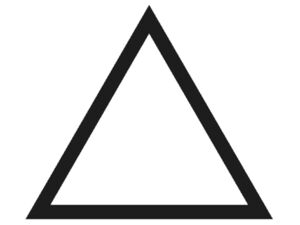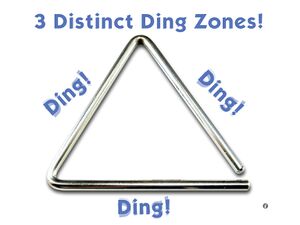Triangle (musical instrument)
The triangle (as distinct from the basic geometric shape) is a musical instrument that is, as its name suggests, in the shape of a triangle. Come to think of it, it isn't really that distinct from the shape. It's hardly a different thing at all. They both have the same name. If I overheard you telling your wife about a triangle, I wouldn't know which kind of triangle you were referring to, unless a context was supplied. Your wife would know, of course. She always knows.
But I digress. Suffice to say, all triangles are triangles, but not all triangles are triangles. Does that clear everything up? No? Maybe it would clearer if I, like, cracked out some italics or some shit. Too bad I don't know how to do that.
Naming[edit]
As previously discussed, the triangle (the musical instrument, not the shape) is both called a triangle and has the appearance of one. Without citing any sources or undertaking any research, I'm going to jump to the conclusion that whoever invented the triangle looked at their handiwork, noted the fact that its interior angles equalled 180°, and after due deliberation decided to brand their creation the triangle in a stroke of sheer genius.
Let me you stop you right there for a second.
Picture Andrea Amati toiling over his magnum opus in some austere 16th century Italian workshop. Imagine him putting countless hours into perfecting the design. He's wiping his brow. He's taking measurements. He's frantically scrawling on paper, occasionally scrunching some up into a little ball and tossing it aside. Yep- he’s pulling out all the stops. The sweet, sweet noise produced by this invention will be heard for centuries, he can feel it. Eventually, it is complete. Amati steps back and gazes upon the piece of pure perfection before him. He didn't just put maple, ebony and varnish into the instrument- he gave up part of his soul. "This", he whispers, "will be known as the... violin-shape".
Playing[edit]
The process of playing the triangle is known as trigonometry. Through the use of trigonometry, it is possible to extrapolate the point in a song or piece of music where the listener dismisses the inclusion of the triangle in the piece as a trite novelty.
Applications in classical music[edit]
Those who practice trigonometry have been the subject of much controversy, as when they are included in a full orchestra, they are the only musicians to require electronic equipment, namely calculators. Some view this as an affront to an orchestra's prestige and traditions.


